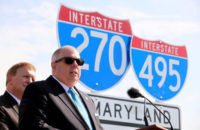Engineers are failing the public by not effectively communicating risk, the cost of protection and alternatives for mitigating natural disasters, says Robert Gilbert.
"The civil part of civil engineering is working with owners, operators and the public to figure out how we mitigate these natural hazards," says Gilbert, a University of Texas professor who gave the closing plenary lecture March 12 at the Annual Congress of the Geo-Institute of the American Society of Civil Engineers in New Orleans.
The devastation caused by Hurricane Katrina and the levee failures have created "a very palpable lack of trust for what engineers can and can't do," Gilbert says. "People generally trust engineers, but not in New Orleans."
That environment is anathema to the sort of open, intellectual discourse necessary to solve such a complicated problem. "We all, professionals in every aspect of what we do, need to do what we can to improve the situation in New Orleans," Gilbert says. "If the Corps of Engineers is really responsible for everything, they could fix everything. But neither one of those is true."
The lack of trust is warranted, considering the circumstances, adds.
To begin his presentation, Gilbert started with a narrative. "It was an intense storm that intensified as it moved through the Gulf of Mexico, created a tremendous storm surge and people drowned in their attics," said Gilbert. "The year was 1964, and the hurricane was Betsy."
Forty years later, it happened again. "Our engineering community was charged with making people safe. We need to start looking at what we can do to help mitigate natural hazards," Gilbert says. "We can take a central role because we understand what we can and can't do as engineers."
The disconnect between science and practical application is a bigger culprit than faulty engineering, Gilbert says. Because engineers are so afraid of putting a price tag on human life, they are often reticent to discuss the practicality of solutions. "If it's going to cost $20 billion to make the system stronger, maybe it's just not worth it," he says. "We as civil engineers generally say we can't equate life with dollars, but that is what we do. When we use a factor of safety; we are implicitly making that decision. When you buy life insurance, you are doing it. We are putting a value on human life. It's our responsibility to step up and admit that, and take part in the conversations about that."
Don't make the mistake of think he believes there's no use to the work of bringing the Greater New Orleans Hurricane and Storm Damage Risk Reduction System to a 100-year level of protection by 2011, cautions Gilbert. "We need to make sure we do it in concert with other things" like implementing effective evacuation plans and building higher, more-fortified housing, he says. "We need to look at the whole system, not the individual pieces of it."
As a practical matter, if every component of New Orleans' levee system were built to the same standard as one single dam, "we as engineers can show how difficult it is to operate and maintain something as long and complicated as this system," Gilbert says. "It gets to the point that it will not be very reliable."
Quantifying risk is just one part of the puzzle, and a part that is difficult for even the most learned professionals to interpret, he says. "You can get lost in risk analysis. People get caught up in all the numbers and forget why they're doing it."
The engineering community is obliged to engage in a public dialogue about probabilities and uncertainties, so individuals can fully comprehend risk and embrace mitigations. "We can talk about the fact that we don't know, and that there is a lot of uncertainty," Gilbert says. "We don't know about global warming and about how that will affect the intensity of future storms. We can help put values on systems and help people come up with ways of comparing various alternatives. We can calculate things that have meaning and help evaluate the best use of our resources."
Ultimately, the public will put the price tag on the solutions, Gilbert says, so it should be aware of risk and help make decisions. "I think it is our responsibility to take a central role to help mitigate natural hazards."
As he concluded, the final slide of his presentation simply said this:
"ASCE Code of Ethics, Canon #1. Engineers shall hold paramount the safety, health and welfare of the public."


Post a comment to this article
Report Abusive Comment